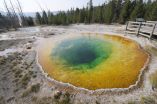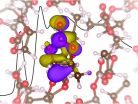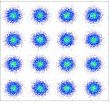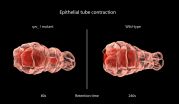(Press-News.org) WASHINGTON D.C., December 19, 2014 - Researchers at Montana State University and Brandenburg University of Applied Sciences in Germany have created a simple mathematical model based on optical measurements that explains the stunning colors of Yellowstone National Park's hot springs and can visually recreate how they appeared years ago, before decades of tourists contaminated the pools with make-a-wish coins and other detritus.
The model, and stunning pictures of the springs, appear today in the journal Applied Optics, which is published by The Optical Society (OSA).
If Yellowstone National Park is a geothermal wonderland, Grand Prismatic Spring and its neighbors are the ebullient envoys, steaming in front of the camera and gracing the Internet with their ethereal beauty. While the basic physical phenomena that render these colorful delights have long been scientifically understood -- they arise because of a complicated interplay of underwater vents and lawns of bacteria -- no mathematical model existed that showed empirically how the physical and chemical variables of a pool relate to their optical factors and coalesce in the unique, stunning fashion that they do.
"What we were able to show is that you really don't have to get terribly complex - you can explain some very beautiful things with relatively simple models," said Joseph Shaw, a professor at Montana State University and director of the university's Optical Technology Center. Shaw, along with his Ph.D. student Paul Nugent and German colleague Michael Vollmer, co-authored the new paper.
Using a relatively simple one-dimensional model for light propagation, the group was able to reproduce the brilliant colors and optical characteristics of Yellowstone National Park's hot springs by accounting for each pool's spectral reflection due to microbial mats, their optical absorption and scattering of water and the incident solar and diffuse skylight conditions present when measurements were taken.
"When we started the study, it was clear we were just doing it for fun," Vollmer said. But they quickly discovered there was very little in the scientific literature on the subject. That's when things got interesting.
Montana State University, in Bozeman, Mont., is a short drive away from Yellowstone National Park. In the summer of 2012, Vollmer, on sabbatical from the Brandenburg University of Applied Sciences, travelled with Shaw and Nugent to the park. Using handheld spectrometers, digital SLR cameras for visible images and long wave infrared thermal imaging cameras for non-contact measurement of the water temperatures, the group took measurements at a number of pools in Yellowstone, including Morning Glory Pool, Sapphire Pool and Grand Prismatic Spring. Using these data, along with previously available information about the physical dimensions of the pools, they were able to create a simple model whose renderings of the pools were strikingly similar to actual photographs.
In the case of Morning Glory Pool, they were even able to simulate what the pool once looked like between the 1880s and 1940s, when its temperatures were significantly higher. During this time, its waters appeared a uniform deep blue. An accumulation of coins, trash and rocks over the intervening decades has partially obscured the underwater vent, lowering the pool's overall temperature and shifting its appearance to a terrace of orange-yellow-green. This change from blue was demonstrated to result from the change in composition of the microbial mats, as a result of the lower water temperature.
A general relationship between shallow water temperature (hence microbial mat composition) and observed colors was confirmed in this study. However, color patterns observed in deeper segments of the pool are caused more by absorption and scattering of light in the water. These characteristics - mats having greater effect on color in shallow water, and absorption and scattering winning out in the deeper areas - are consistent across all the measured pools.
"Our paper describes a very simple, 1-dimensional model, that gives the first clue if you really want to do more," Vollmer said.
"We didn't start this project as experts on thermal pools," Shaw said. "We started this project as experts on optical phenomena and imaging, and so we had a lot to learn."
"There are people at my university who are world experts in the biological side of what's going on in the pools," Shaw said. "They're looking for ways to monitor changes in the biology - when the biology changes, that causes color changes - so we're actually looking at possibilities of collaborating in the future."
Future work for Nugent, Vollmer and Shaw includes delving further into infrared imaging at Yellowstone National Park.
INFORMATION:
Paper: P.W. Nugent, J.A. Shaw and M. Vollmer, "Colors of Thermal Pools at Yellowstone National Park," (http://www.opticsinfobase.org/ao/abstract.cfm?uri=ao-54-4-B128), Applied Optics, Vol. 54, Issue 4, pp. B128-B139 (2015)
About Applied Optics
Applied Optics publishes articles emphasizing applications-centered research in optics, moving the potential of science and technology to the practical. Published three times each month, Applied Optics reports significant optics applications from optical testing and instrumentation to medical optics...from holography to optical neural networks...from lidar and remote sensing to laser materials processing. Each issue contains content from three divisions of editorial scope: Optical Technology; Information Processing; and Lasers, Photonics, and Environmental Optics. It is edited by Joseph Mait of the U.S. Army Research Laboratory. For more information, visit http://www.OpticsInfoBase.org/AO.
About OSA
Founded in 1916, The Optical Society (OSA) is the leading professional organization for scientists, engineers, students and entrepreneurs who fuel discoveries, shape real-life applications and accelerate achievements in the science of light. Through world-renowned publications, meetings and membership initiatives, OSA provides quality research, inspired interactions and dedicated resources for its extensive global network of optics and photonics experts. OSA is a founding partner of the National Photonics Initiative and the 2015 International Year of Light. For more information, visit http://www.osa.org.
Despite showing interest in web or mobile apps to help manage their Type 2 diabetes, only a small number of older adults actually use them, says a new study from the University of Waterloo. Approximately 2.2 million Canadians are living with Type 2 diabetes, 2 million of whom are age 50 or older.
The study, which appears in the online edition of the Journal of Diabetes Science and Technology, found that although more than 90 per cent of research participants owned a computer or had daily Internet access, just 18 per cent used applications on this technology to help manage ...
The lithium-ion batteries that mobilize our electronic devices need to be improved if they are to power electric vehicles or
store electrical energy for the grid. Berkeley Lab researchers looking for a better understanding of liquid electrolyte may have found a pathway forward. A team led by Richard Saykally, a chemist with Berkeley Lab's Chemical Sciences Division, David Prendergast, a theorist with Berkeley Lab's Molecular Foundry, and Steven Harris, a chemist with the Lab's Materials Sciences Division, found surprising results in the first X-ray absorption spectroscopy ...
It's like a scene from a gamer's wildest dreams: 12 high-definition, 55-inch 3D televisions all connected to a computer capable of supporting high-end, graphics-intensive gaming.
On the massive screen, images are controlled by a Wii remote that interacts with a Kinnect-like Bluetooth device (called SmartTrack), while 3D glasses worn by the user create dizzying added dimensions.
But this real-life, computer-powered mega TV is not for gaming. It's for engineering.
Welcome to Brigham Young University's VuePod, a 3D immersive visualization environment run by BYU's Department ...
New research indicates that reducing emergency surgery for three common procedures by 10 percent could cut $1 billion in health care costs over 10 years.
As hospitals and health systems increasingly focus on addressing the rising cost of health care in the United States, and with the expense of surgical care playing a major role, physician researchers and others across the healthcare industry are working to identify innovative ways to reduce surgical costs.
In new findings published online in the journal Annals of Surgery on December 19, 2014, researchers determined ...
Researchers from the University of Southampton have revealed a breakthrough in optical fibre communications.
Academics from the University's Optoelectronics Research Centre (ORC) have collaborated with colleagues at Eblana Photonics Inc, in Ireland, to develop an approach that enables direct modulation of laser currents to be used to generate highly advanced modulation format signals.
The research, published in the journal Nature Communications, explores a radically new approach to the generation of spectrally-efficient advanced modulation format signals as required ...
Carnivorous plants catch and digest tiny animals in order and derive benefits for their nutrition. Interestingly the trend towards vegetarianism seems to overcome carnivorous plants as well. The aquatic carnivorous bladderwort, which can be found in many lakes and ponds worldwide, does not only gain profit from eating little animals but also by consuming algae and pollen grains. This results in survival in aquatic habitats where prey animals are rare, and in increased fitness if the animals and algae are caught in a well-balanced diet. An Austrian research group around ...
Researchers at the Mechanobiology Institute (MBI), National University of Singapore (NUS) have identified a novel mechanosensitive regulation of epithelial tube contraction. These findings are published on 19 December 2014 in Current Biology (Pei Yi Tan and Ronen Zaidel-Bar. Transient membrane localization of SPV-1 drives cyclical actomyosin contractions in the C. elegans spermatheca, Current Biology, 19 Dec 2014, doi: 10.1016/j.cub.2014.11.033)
Regulating tube constriction
Many of the fundamental processes of life rely on biological structures known as epithelial ...
Over the past decade, ocean acidification has received growing recognition not only in the scientific area. Decision-makers, stakeholders, and the general public are becoming increasingly aware of "the other carbon dioxide problem". It is time to reflect on the successes and deficiencies of ocean acidification research and to take a look forward at the challenges the fastest growing field of marine science is facing. In the January issue of the journal Nature Climate Change Ulf Riebesell, professor for Biological Oceanography at GEOMAR Helmholtz Centre for Ocean Research ...
Bremerhaven/Germany, 18 December 2014. Ingestion of microplastic particles does not mechanically affect marine isopods. This was the result of a study by biologists at the North Sea Office of the Alfred Wegener Institute, Helmholtz Centre for Polar and Marine Research (AWI) that was published recently in the journal Environmental Science and Technology. The study marks the launch of a series of investigations aimed at forming a risk matrix on the sensitivity of different marine species to microplastic pollution.
Uptake of large plastic items by birds and fish may cause ...
In a recent study from Lund University in Sweden, researchers have used new technology to study extremely fast processes in solar cells. The research results form a concrete step towards more efficient solar cells.
The upper limit for the efficiency of normal solar cells is around 33 per cent. However, researchers now see a possibility to raise that limit to over 40 per cent, thereby significantly improving the potential of this energy source.
The experiments in the present study involved 'juggling' on quantum level with photons, i.e. light particles, and electrons. ...






